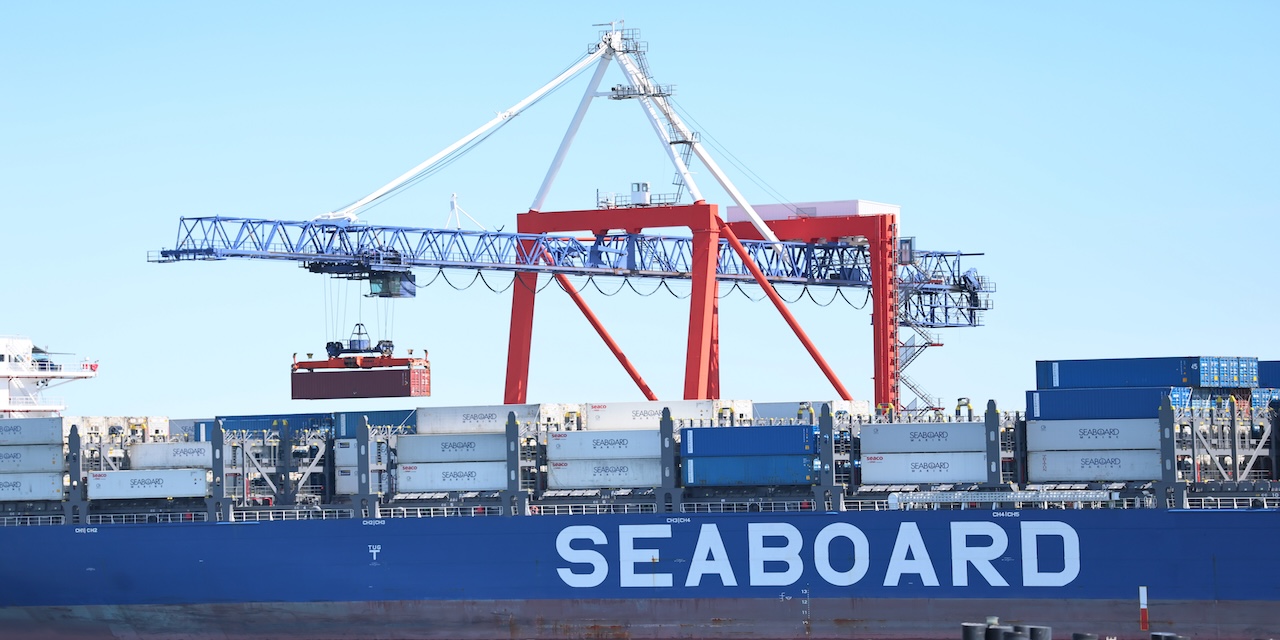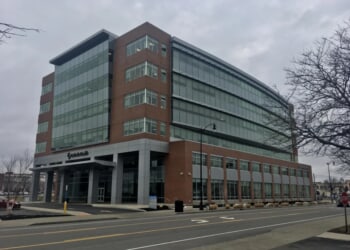
Jordan McGillis joins Brian Anderson to discuss his story, “On the Twenty-First-Century Waterfront,” and the tension between labor unions and technology at American ports.
Brian Anderson: Welcome back to the 10 Blocks podcast. This is Brian Anderson, the editor of City Journal. Joining me on the show today is Jordan McGillis, who’s City Journal’s economics editor. Jordan writes about energy technology, economic innovation, geopolitics, and other issues for City Journal. Today we’re going to discuss his superb essay from our spring issue, “On the Twenty-First-Century Waterfront,” which looks at the opposition of some longshoremen unions to automation technologies and American ports, and explores just generally the role of ports in American prosperity. So Jordan, thanks very much for joining us.
Jordan McGillis: Great to be on this side of the microphone, Brian.
Brian Anderson: Yeah, your essay, and I do encourage readers to go out and check it out, reports on how U.S. ports, especially on the East Coast, have been lagging technologically behind ports in some other countries, which have embraced automation and robotics in a way that the U.S. ports have not. So I wonder if you could just describe how American ports do currently stack up against international competitors, especially China when it comes to the adoption of automation, robotics, artificial intelligence, this kind of technological upgrade.
Jordan McGillis: Yes. There’s a couple of different planes to analyze this issue from, one of which is the China competition, and as with many other areas of the industrial economy, China is rapidly moving from a primitive state to a state that’s more advanced than ours in terms of its production capability, its transportation capability, and indeed its logistics at ports. China has a couple of enormous, very new, just a couple of decades old ports near Shanghai and then down near Shenzhen, and these ports are largely operated in autonomous fashion. The other comparison that I think is more a little bit more applicable though is Europe, which has a longer industrial history and more comparable household economics and labor economics to the United States, but the comparison to Rotterdam, U.S. ports and then at the leading European port of Rotterdam, that comparison is not favorable to the U.S. at all either.
The Port of Rotterdam has gone to and almost fully automated and roboticized process. It’s a really interesting evolution that they’ve undergone. Starting in the 1990s, they began taking people off of the waterfront and putting them basically inside of office buildings behind the fence, and they use remote controls and now a lot of artificial intelligence to get containers off of ships, get them onto the rail and road network and get them out of the port. Rotterdam currently has a total employment figure that is less than half of that of the Port of New York and New Jersey, and yet it moves about 50 percent more container volume each year, so it’s doing more with fewer people and that the cost that is borne by Americans here is basically unnecessary labor costs. That filters down then to our consumer prices and makes all of our lives a little bit less affordable as a result.
Brian Anderson: This kind of opposition to technology, because that’s what you’re talking about, the labor unions in the U.S. have resisted making these changes. This is more prominent on the East Coast ports than the West Coast ports? Correct.
Jordan McGillis: I spent my time focusing on the East Coast ports. The West Coast ports have a lot of problems. There’s no question about that. I don’t want to present them as being exceptionally good, but there is evidence that the adoption of partial automation at the Ports of Los Angeles and Long Beach has improved their efficiency. The East Coast ports primarily New York, New Jersey that has been lagging and that’s controlled by a labor union called the International Longshoremen’s Association. It’s been entrenched on the East Coast, the ILA has, for more than 50 years. In the fifties and sixties, it really got foothold and has effectively controlled the Northeast and now the Southeast and Gulf Coast has set terms that are really onerous for the wider economy and it results in tens, I mean about $10 billion probably, as a back of the envelope number, on additional costs that are then passed on to the shipping companies, to the importers and then onto consumer goods.
If you think about things like automobiles that are coming from Europe or general commodities like cocoa beans or iron ores, those sorts of things that are coming in from other countries through East Coast ports, the costs are higher, and what we’re seeing now is this really interesting political dynamic in which the MAGA movement has allied with old school labor unions. We saw this at the Republican convention last summer, and the president has basically made peace in a way that past Republican leaders have not with this sort of old blue collar labor mindset, which does want to restrict adoption of technology and on the East Coast ports that’s now resulted in a new deal by which the ILA longshoremen are going to get paid about double what other unionized blue collar workers are in the tri-state area, and they’re also going to have an agreement that for every semi-autonomous crane, there’s a new worker hired. So even if we add this labor reducing technology, the political dynamics have resulted in simply unnecessary costs being layered on top of it. So it’s undermining the very value of the automation, which would be to reduce the need to pay that human worker.
Brian Anderson: Introducing these technologies presumably as significant costs, especially initially, right, with a lot of upfront costs?
Jordan McGillis: Of course, that’s why China has been able to get out ahead at their Yangshan port, it didn’t exist 20 years ago, so all that capital investment was new and of course provided on favorable terms by the central and local government there, but we have solid port infrastructure that was at one time world leading. I talk in this piece about the New Jersey side of the New York and New Jersey port system upgrading in the 1960s to accommodate large container ships, so we were on the forefront then. The establishment of those large container ports has resulted in now the entrenched and antiquated technology sort of blocking the new technology that China’s able to get quickly, and when you compare to Rotterdam, what I learned through my research and my conversations with experts in this field, Rotterdam actually also built in a sort of new domain. They extended land out into the water. They weren’t converting to this autonomous behind the fence operation. They reclaimed land from the North Sea in that region at the Port of Rotterdam and built the new style effectively in a greenfield form. We don’t have that luxury in the tri-state area, partly due to labor, but also due to just the broader environmental regulations, which hopefully it’s something I can cover in a future City Journal piece, but we face a lot of constraints for the type of development that has enabled the Chinese ports to be really effective and also enabled European ports to be effective in a way that we haven’t been recently.
Brian Anderson: The union fears that the technology will basically replace all workers. I think that’s an exaggeration, right?
Jordan McGillis: Certainly in the ensuing decades here, it’s going to be complimentary, not something that can fully replace the human presence, especially when you think about the variables that are outside of our control with ports, first and foremost, weather and water. You’re going to need humans to respond to unexpected situations, and so the Port of Rotterdam still has I think something like 1,700 employees, whereas Port of New York and New Jersey has well over 3,000, so there’s still going to be a lot of people who are doing these jobs, but they’re going to be doing it in a safer way removed from clanging and banging of metal down right at the waterfront in a perfect world, and that’s a good thing. These are jobs that are, first I want to establish they are skilled jobs that the longshoremen are doing. They’re also dangerous jobs, and if we can get people to be able to perform the same function in a safer way, that’s a win all around. But this labor union sort of views its control as almost a hereditary fiefdom. There’s a lot of stories about families that pass on the opportunity in a way that’s sort of informal, not a standardized labor practice, and they have a very protectionist mindset on those jobs and passing on those benefits of those outsized wages to the next generation.
Brian Anderson: You look at the resistance to port automation in the U.S., it really does seem to be part of a broader conflict that’s emerging between the productivity benefits of automation, AI, and desires of workers who really don’t want to be replaced by machines. You can understand that in some cases they do make a very good living. Are there costs and benefits that we need to balance here?
Jordan McGillis: Something that I think is really interesting is how this port automation story fits into the broader labor and technology discussion that you’re describing. It sort of does so in unexpected ways. The way that I first was thinking about it is in the standard conflict between technology and people who are previously doing manual jobs, but what I realized is that there’s a unique element here, and it’s tradeability in the economy. With something like manufacturing, if you think about automobiles in their heyday of mass employment in the Midwest, what ultimately made that style of employment and community anchoring thelocal economy evaporate is that companies were able to take the operations elsewhere. First it was to the Sunbelt, and then later with we saw the rise of Japanese and Korean and now perhaps even Chinese automakers. But when you’re looking at things that are produced at scale and shipped, potentially can be shipped across distances, it enables labor to be eliminated as a cost axis.
But in this case of the ports, that’s not possible. You can’t move the Port of New York and New Jersey, so there’s this element in which the longshoremen have a cornered resource, and so they’re able to fight against the technological change in a way that was really futile for people like auto workers. They have the politicized control of this natural infrastructure and are able to extract their terms due to the longstanding relationship. But what’s been fascinating just in the last month or two in the aftermath of the implementation on April 2nd of the wide reaching tariffs from the Trump administration is that now we’re seeing a break between the longshoremen and the MAGA movement because the tariffs will directly affect the volume of goods down the road that they’ll be able to load and unload off of ships. Even though something like the tariffs and the outlook of the MAGA movement is this sort of pro worker maneuver. I don’t think that’s ultimately true, but MAGA certainly does. That’s being viewed with antipathy by this particular segment of the blue collar workforce, the longshoremen. So there’s this tension between the longshoremen and other people that work in the same style of job, whether it be truck drivers or manufacturing workers, because they face very different economic opportunities and constraints. Primarily, the fact, again that the longshoremen have this cornered resource in the form of the port infrastructure.
Brian Anderson: You noted that President Trump has signaled his support for Longshoreman’s Union posting on Truth Social, that he studied automation. He knows everything there is to know about it, and the amount of money saved is nowhere near the distress it’s causing or going to cause for American workers. Is this just sheer politics on Trump’s part? What’s your take on his position? What do you think are going to be the political ramifications going forward?
Jordan McGillis: I think that in the long run, technology creates economic opportunity and we need to keep that bit of wisdom in mind. We evaluate all of these changes in the workforce composition that does occur through technological change. When I was speaking with a couple of the port experts, they expressed to me that the reason we don’t see super clear numbers from shipping companies and from port operators on the cost benefit analysis for port automation is that it really genuinely is eliminating labor in the long run, and it’s not eliminating the role of human labor in the long run, but it’s not necessarily clear that these automated ports are moving more tonnage. So the shipping companies that would love to see the ports automated, they do recognize that it isn’t, doesn’t necessarily going to be able to move more, but they’re going to be able to do it at a lower cost. That’s a third rail sort of thing to say. So they’re sort of concealing the numbers there. They want to see it happen, but not acknowledge that what they would ultimately benefit from is that elimination of the labor cost.
So from the Trump administration perspective or the wider New Right, you might say that’s a pretty easy political win to score is to acknowledge, yes, this is technology that is potentially displacing workers and upending livelihoods. My outlook here is that we do need to take a broader, more holistic economy-wide view, and by bringing new technologies into different industries, we’re going to drive the American productivity frontier further, and we’re going to create more opportunities, of course, in different sorts of jobs, different fields in the future. To go back to the Rotterdam situation, they over the course of 20, 30 years implemented this new system with the workers almost entirely being beyond the fence, only going inside the fence in unexpected situations. Again, there’s still a lot of people employed, well over a thousand longshoremen are now working at control panels instead of up on the top of cranes and being right there where they’re potentially in harm’s way. So that’s the sort of change we’re talking about. But artificial intelligence, robotics automation, these are things that can create widely shared economic benefits and the ports will be one area where they could very clearly bring that lower cost overall, and we don’t know what the exact landscape for labor and for our industrial makeup is going to be in the future, but productivity gains do filter throughout an economy and benefit everyone, even if there are these painful short-term costs, which is not expanding a particular sort of employment or even shaving certain jobs from an industrial mix.
Brian Anderson: Well, thanks very much, Jordan. It’s really a fascinating topic, and an important one for the future of the country. Please check out Jordan McGillis work on the City Journal website. We’ll link to this story, which again is called on the 21st Century waterfront and his other work in the description. You can find City Journal on X @CityJournal and on Instagram @CityJournal_mi. If you like what you’ve heard on the podcast, please give us a nice rating on iTunes.
Jordan, thanks so much for coming on 10 Blocks. As a reminder, we’ve also launched a brand new twice weekly podcast called simply enough, the City Journal Podcasts hosted by CJ’s Charles Lehman. It explores issues in the news with a rotating group of MI policy experts. New episodes of that are dropping every Monday and Thursday, so please be sure to check it out on YouTube and subscribe. Jordan, thanks again.
Photo by Michael M. Santiago/Getty Images

















